| Listing 1 - 10 of 23 | << page >> |
Sort by
|
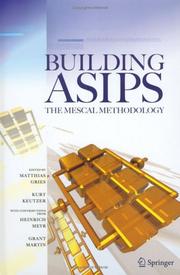
ISBN: 1280618892 9786610618897 0387261281 0387260579 1441938605 Year: 2005 Publisher: New York : Springer,
Abstract | Keywords | Export | Availability | Bookmark
 Loading...
Loading...Choose an application
- Reference Manager
- EndNote
- RefWorks (Direct export to RefWorks)
An increasing number of system designers are using ASIP’s rather than ASIC’s to implement their system solutions. Building ASIPs: The Mescal Methodology gives a simple but comprehensive methodology for the design of these application-specific instruction processors (ASIPs). The key elements of this methodology are: Judiciously using benchmarking Inclusively identifying the architectural space Efficiently describing and evaluating the ASIPs Comprehensively exploring the design space Successfully deploying the ASIP This book includes demonstrations of applications of the methodologies using the Tipi research framework as well as state-of-the-art commercial toolsets from CoWare and Tensilica.
Application-specific integrated circuits. --- Microprocessors. --- Minicomputers --- ASICs (Integrated circuits) --- Integrated circuits --- Engineering. --- Engineering, general. --- Construction --- Industrial arts --- Technology --- Technology and Engineering.
Book
ISBN: 0769526276 1509097430 Year: 2005 Publisher: [Place of publication not identified] IEEE Computer Society
Abstract | Keywords | Export | Availability | Bookmark
 Loading...
Loading...Choose an application
- Reference Manager
- EndNote
- RefWorks (Direct export to RefWorks)
Microprocessors --- Integrated circuits --- Systems on a chip --- Electrical & Computer Engineering --- Engineering & Applied Sciences --- Electrical Engineering --- Minicomputers --- SOC design --- Systems on chip --- Embedded computer systems --- Testing --- Verification
Book
ISBN: 1281016535 9786611016531 008047375X 9780080473758 0750666641 9780750666640 Year: 2005 Publisher: Amsterdam Boston Elsevier/Newnes
Abstract | Keywords | Export | Availability | Bookmark
 Loading...
Loading...Choose an application
- Reference Manager
- EndNote
- RefWorks (Direct export to RefWorks)
John Morton offers a uniquely concise and practical guide to getting up and running with the PIC Microcontroller. The PIC is one of the most popular of the microcontrollers that are transforming electronic project work and product design, and this book is the ideal introduction for students, teachers, technicians and electronics enthusiasts. Assuming no prior knowledge of microcontrollers and introducing the PIC Microcontroller's capabilities through simple projects, this book is ideal for electronics hobbyists, students, school pupils and technicians. The step-by-step explanation
Programmable controllers. --- Integrated circuits --- Microelectronics. --- Microcomputers --- Home computers --- Micro computers --- Micros (Microcomputers) --- PCs (Microcomputers) --- Personal computers --- Small computers --- Minicomputers --- Microminiature electronic equipment --- Microminiaturization (Electronics) --- Electronics --- Microtechnology --- Semiconductors --- Miniature electronic equipment --- Controllers, Programmable --- Electronic controllers --- Automatic control --- Design and construction. --- Circuits.
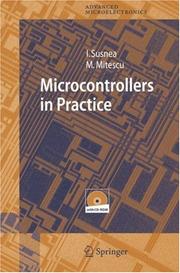
ISBN: 1280306408 9786610306404 3540283080 3540253017 Year: 2005 Volume: 18 Publisher: Berlin ; New York : Springer,
Abstract | Keywords | Export | Availability | Bookmark
 Loading...
Loading...Choose an application
- Reference Manager
- EndNote
- RefWorks (Direct export to RefWorks)
Stressing common characteristics and real applications of the most used microcontrollers, this practical guide provides readers with hands-on knowledge of how to implement three families of microcontrollers (HC11, AVR, and 8051). Unlike the rest of the ocean of literature on individual chips, Microcontrollers in Practice supplieS side-by-side comparisons and an overview that treats the systems as resources available for implementation. Packed with hundred of practical examples and exercises to foster mastery of concepts and details, the guide also includes several extended projects. By treating the less expensive 8-bit and RISC microcontrollers, this information-dense manual equips students and home-experimenters with the know-how to put these devices into operation.
Microprocessors. --- Programmable controllers. --- Digital control systems. --- Motorola 68HC11 (Microprocessor) --- 68HC11 (Microprocessor) --- Microprocessors --- Automatic control --- Electronic digital computers --- Controllers, Programmable --- Electronic controllers --- Minicomputers --- Electronics. --- Nanotechnology. --- Engineering. --- Electronics and Microelectronics, Instrumentation. --- Engineering, general. --- Construction --- Industrial arts --- Technology --- Molecular technology --- Nanoscale technology --- High technology --- Electrical engineering --- Physical sciences --- Microelectronics. --- Microminiature electronic equipment --- Microminiaturization (Electronics) --- Electronics --- Microtechnology --- Semiconductors --- Miniature electronic equipment
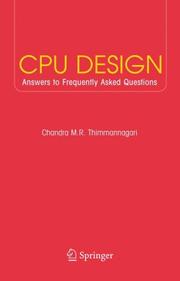
ISBN: 1280190310 978038723800X 9786610190317 038723800X 0387237992 Year: 2005 Publisher: New York : Springer,
Abstract | Keywords | Export | Availability | Bookmark
 Loading...
Loading...Choose an application
- Reference Manager
- EndNote
- RefWorks (Direct export to RefWorks)
I am honored to write the foreword for Chandra Thimmannagari’s book on CPU design. Chandra’s book provides a practical overview of Microprocessor and high end ASIC design as practiced today. It is a valuable addition to the literature on CPU design, and is made possible by Chandra’s unique combination of extensive hands-on CPU design experience at companies such as AMD and Sun Microsystems and a passion for writing. Technical books related to CPU design are almost always written by researchers in academia or industry and tend to pick one area, CPU architecture/Bus architecture/ CMOS design that is the area of expertise of the author, and present that in great detail. Suchbooks are of great value to students and practitioners in that area. However, engineers working on CPU design need to develop an understanding of areas outside their own to be effective. CPU design is a multi dimensional problem and one dimensional optimization is often counterproductive.
Microprocessors --- Minicomputers --- Design and construction. --- Mini computers --- Miniature computers --- Small computers --- Electronic digital computers --- Miniature electronic equipment --- Systems engineering. --- Electronics. --- Computer engineering. --- Circuits and Systems. --- Electronics and Microelectronics, Instrumentation. --- Electrical Engineering. --- Computers --- Electrical engineering --- Physical sciences --- Engineering systems --- System engineering --- Engineering --- Industrial engineering --- System analysis --- Design and construction --- Electronic circuits. --- Microelectronics. --- Electrical engineering. --- Microminiature electronic equipment --- Microminiaturization (Electronics) --- Electronics --- Microtechnology --- Semiconductors --- Electron-tube circuits --- Electric circuits --- Electron tubes --- Electric engineering
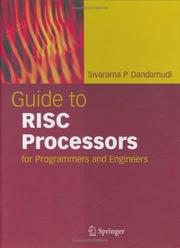
ISBN: 1280337230 9786610337231 0387274464 0387210172 144191935X Year: 2005 Publisher: New York : Springer,
Abstract | Keywords | Export | Availability | Bookmark
 Loading...
Loading...Choose an application
- Reference Manager
- EndNote
- RefWorks (Direct export to RefWorks)
Recently, there has been a trend toward processor design based on the RISC (Reduced Instruction Set Computer) model: Example RISC processors are the MIPS, SPARC, PowerPC, ARM, and even Intel’s 64-bit processor Itanium. This guidebook provides an accessible and all-encompassing compendium on RISC processors, introducing five RISC processors: MIPS, SPARC, PowerPC, ARM, and Itanium. Initial chapters explain the differences between the CISC and RISC designs and clearly discuss the core RISC design principles. The text then integrates instruction on MIPS assembly language programming, thereby enabling readers to concretely grasp concepts and principles introduced earlier. Readers need only have a basic knowledge of any structured, high-level language to obtain the full benefits here. Features: *Includes MIPS simulator (SPIM) download instructions, so that readers can get hands-on assembly language programming experience *Presents material in a manner suitable for flexible self-study • Assembly language programs permit reader executables using the SPIM simulator • Integrates core concepts to processor designs and their implementations • Supplies extensive and complete programming examples and figures • Contains chapter-by-chapter overviews and summaries * Provides source code for the MIPS language at the book’s website Guide to RISC Processors provides a uniquely comprehensive introduction and guide to RISC-related concepts, principles, design philosophy, and actual programming, as well as the all the popular modern RISC processors and their assembly language. Professionals, programmers, and students seeking an authoritative and practical overview of RISC processors and assembly language programming will find the guide an essential resource. Sivarama P. Dandamudi is a professor of computer science at Carleton University in Ottawa, Ontario, Canada, as well as associate editor responsible for computer architecture at the International Journal of Computers and Their Applications. He has more than two decades of experience teaching about computer systems and organization. Key Topics * Processor design issues * Evolution of CISC and RISC processors * MIPS, SPARC, PowerPC, Itanium, and ARM architectures * MIPS assembly language * SPIM simulator and debugger * Conditional execution * Floating-point and logical and shift operations * Number systems Computer Architecture/Programming Beginning/Intermediate Level.
Reduced instruction set computers. --- Computer architecture. --- Assembler language (Computer program language) --- Microprocessors --- Programming. --- Assembler languages (Electronic computers) --- Programming languages (Electronic computers) --- Architecture, Computer --- RISCs (Computers) --- Computers --- MMIX (Computer architecture) --- Computer science. --- Microprogramming. --- Software engineering. --- Computer network architectures. --- Processor Architectures. --- Control Structures and Microprogramming. --- Software Engineering/Programming and Operating Systems. --- Computer Systems Organization and Communication Networks. --- Programming Techniques. --- Computer software engineering --- Engineering --- Computer programming --- Informatics --- Science --- Architectures, Computer network --- Network architectures, Computer --- Computer architecture --- Microprocessors. --- Microprogramming . --- Computer organization. --- Computer programming. --- Electronic computer programming --- Electronic data processing --- Electronic digital computers --- Programming (Electronic computers) --- Coding theory --- Organization, Computer --- Minicomputers --- Programming
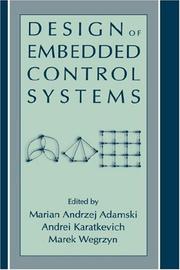
ISBN: 1280700858 9786610700851 0387283277 0387236309 1441936467 Year: 2005 Publisher: New York : Springer,
Abstract | Keywords | Export | Availability | Bookmark
 Loading...
Loading...Choose an application
- Reference Manager
- EndNote
- RefWorks (Direct export to RefWorks)
A set of original results in the ?eld of high-level design of logical control devices and systems is presented in this book. These concern different aspects of such important and long-term design problems, including the following, which seem to be the main ones. First, the behavior of a device under design must be described properly, and some adequate formal language should be chosen for that. Second, effective algorithmsshouldbeusedforcheckingtheprepareddescriptionforcorrectness, foritssyntacticandsemanticveri?cationattheinitialbehaviorlevel.Third,the problem of logic circuit implementation must be solved using some concrete technological base; ef?cient methods of logic synthesis, test, and veri?cation should be developed for that. Fourth, the task of the communication between the control device and controlled objects (and maybe between different control devices)waitsforitssolution.Alltheseproblemsarehardenoughandcannotbe successfully solved without ef?cient methods and algorithms oriented toward computer implementation. Some of these are described in this book. The languages used for behavior description have been descended usually from two well-known abstract models which became classic: Petri nets and ?nite state machines (FSMs). Anyhow, more detailed versions are developed and described in the book, which enable to give more complete information concerningspeci?cqualitiesoftheregardedsystems.Forexample,themodelof parallelautomatonispresented,whichunliketheconventional?niteautomaton can be placed simultaneously into several places, calledpartial. As a base for circuit implementation of control algorithms, FPGA is accepted in majority of cases.
Digital control systems --- Embedded computer systems --- Design and construction. --- Automatic control --- Electronic digital computers --- Computer engineering. --- Computer aided design. --- Microprogramming. --- Computer science. --- Control and Systems Theory. --- Electrical Engineering. --- Computer-Aided Engineering (CAD, CAE) and Design. --- Control, Robotics, Mechatronics. --- Control Structures and Microprogramming. --- Processor Architectures. --- Informatics --- Science --- Computer programming --- CAD (Computer-aided design) --- Computer-assisted design --- Computer-aided engineering --- Design --- Computers --- Design and construction --- Control engineering. --- Electrical engineering. --- Computer-aided engineering. --- Robotics. --- Mechatronics. --- Microprogramming . --- Microprocessors. --- Minicomputers --- Mechanical engineering --- Microelectronics --- Microelectromechanical systems --- Automation --- Machine theory --- CAE --- Engineering --- Electric engineering --- Control engineering --- Control equipment --- Control theory --- Engineering instruments --- Programmable controllers --- Data processing
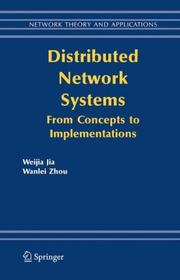
ISBN: 1280190353 9780387238409 9786610190355 0387238409 0387238395 1489983414 1402075545 Year: 2005 Publisher: New York, NY : Springer US : Imprint: Springer,
Abstract | Keywords | Export | Availability | Bookmark
 Loading...
Loading...Choose an application
- Reference Manager
- EndNote
- RefWorks (Direct export to RefWorks)
This textbook covers both theoretical and practical aspects of distributed computing. It describes the client-server model for developing distributed network systems, the communication paradigms used in a distributed network system, and the principles of reliability and security in the design of distributed network systems. Based on theoretical introductions, the book presents various implementation strategies and techniques for building distributed network systems, including examples in TCP/IP communications, the use of remote procedure call and remote method invocation techniques, and the development of web-based applications, distributed databases, and mobile computing systems. Audience The book is suitable for self-study or for use in classes. Most parts of the book have been used by the authors in their teaching of various topics including distributed systems, computer networks, and distributed database systems. The book can also serve as an invaluable guide for computing professionals in their work for the design and implementation of distributed network systems.
Computer networks. --- Electronic data processing --- Distributed processing. --- Distributed computer systems in electronic data processing --- Distributed computing --- Distributed processing in electronic data processing --- Computer networks --- Communication systems, Computer --- Computer communication systems --- Data networks, Computer --- ECNs (Electronic communication networks) --- Electronic communication networks --- Networks, Computer --- Teleprocessing networks --- Data transmission systems --- Digital communications --- Electronic systems --- Information networks --- Telecommunication --- Cyberinfrastructure --- Network computers --- Distributed processing --- Computer science. --- Computer aided design. --- Processor Architectures. --- Computer-Aided Engineering (CAD, CAE) and Design. --- User Interfaces and Human Computer Interaction. --- CAD (Computer-aided design) --- Computer-assisted design --- Computer-aided engineering --- Design --- Informatics --- Science --- Microprocessors. --- Computer-aided engineering. --- User interfaces (Computer systems). --- Interfaces, User (Computer systems) --- Human-machine systems --- Human-computer interaction --- CAE --- Engineering --- Minicomputers --- Data processing
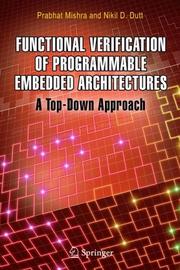
ISBN: 1280234296 9786610234295 0387263993 0387261435 1489973362 Year: 2005 Publisher: New York : Springer,
Abstract | Keywords | Export | Availability | Bookmark
 Loading...
Loading...Choose an application
- Reference Manager
- EndNote
- RefWorks (Direct export to RefWorks)
Validation of programmable architectures, consisting of processor cores, coprocessors, and memory subsystems, is one of the major bottlenecks in current System-on-Chip design methodology. A critical challenge in validation of such systems is the lack of a golden reference model. As a result, many existing validation techniques employ a bottom-up approach to design verification, where the functionality of an existing architecture is, in essence, reverse-engineered from its implementation. Traditional validation techniques employ different reference models depending on the abstraction level and verification task, resulting in potential inconsistencies between multiple reference models. This book presents a top-down validation methodology that complements the existing bottom-up approaches. It leverages the system architect’s knowledge about the behavior of the design through architecture specification using an Architecture Description Language (ADL). The authors also address two fundamental challenges in functional verification: lack of a golden reference model, and lack of a comprehensive functional coverage metric. Functional Verification of Programmable Embedded Architectures: A Top-Down Approach is designed for students, researchers, CAD tool developers, designers, and managers interested in the development of tools, techniques and methodologies for system-level design, microprocessor validation, design space exploration and functional verification of embedded systems.
Embedded computer systems --- Computer architecture. --- Integrated circuits --- Testing. --- Verification. --- Hardware verification --- Integrated circuit verification --- Verification of hardware --- Verification of integrated circuits --- Architecture, Computer --- Embedded systems (Computer systems) --- Computer systems --- Architecture Analysis and Design Language --- Systems engineering. --- Computer science. --- Software engineering. --- Computer aided design. --- Computer system performance. --- Computer engineering. --- Circuits and Systems. --- Processor Architectures. --- Special Purpose and Application-Based Systems. --- Computer-Aided Engineering (CAD, CAE) and Design. --- System Performance and Evaluation. --- Electrical Engineering. --- Computers --- CAD (Computer-aided design) --- Computer-assisted design --- Computer-aided engineering --- Design --- Computer software engineering --- Engineering --- Informatics --- Science --- Engineering systems --- System engineering --- Industrial engineering --- System analysis --- Design and construction --- Electronic circuits. --- Microprocessors. --- Special purpose computers. --- Computer-aided engineering. --- Computer system failures. --- Electrical engineering. --- Electric engineering --- Computer failures --- Computer malfunctions --- Failure of computer systems --- System failures (Engineering) --- Fault-tolerant computing --- CAE --- Special purpose computers --- Minicomputers --- Electron-tube circuits --- Electric circuits --- Electron tubes --- Electronics --- Failures --- Data processing
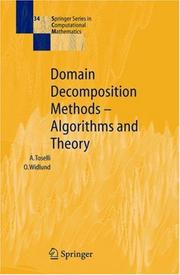
ISBN: 3540206965 3642058485 9786610612949 1280612940 3540266623 Year: 2005 Volume: 34 Publisher: Berlin ; New York : Springer,
Abstract | Keywords | Export | Availability | Bookmark
 Loading...
Loading...Choose an application
- Reference Manager
- EndNote
- RefWorks (Direct export to RefWorks)
Offers a comprehensive presentation of some of the successful domain decomposition preconditioners for finite and spectral element approximations of partial differential equations. This book places strong emphasis on both algorithmic and mathematical aspects. It covers some important methods such as FETI and balancing Neumann-Neumann methods.
Decomposition (Mathematics) --- Differential equations, Partial --- Décomposition (Mathématiques) --- Equations aux dérivées partielles --- 519.63 --- Numerical methods for solution of partial differential equations --- Decomposition method. --- Differential equations, Partial. --- Decomposition method --- Mathematics --- Civil & Environmental Engineering --- Physical Sciences & Mathematics --- Engineering & Applied Sciences --- Operations Research --- Mathematics - General --- Calculus --- 519.63 Numerical methods for solution of partial differential equations --- Décomposition (Mathématiques) --- Equations aux dérivées partielles --- EPUB-LIV-FT LIVMATHE SPRINGER-B --- Partial differential equations --- Method, Decomposition --- Mathematics. --- Microprocessors. --- Software engineering. --- Mathematical analysis. --- Analysis (Mathematics). --- Computer mathematics. --- Numerical analysis. --- Computational Mathematics and Numerical Analysis. --- Analysis. --- Numerical Analysis. --- Computational Science and Engineering. --- Processor Architectures. --- Software Engineering/Programming and Operating Systems. --- Mathematical analysis --- Computer mathematics --- Discrete mathematics --- Electronic data processing --- 517.1 Mathematical analysis --- Computer software engineering --- Engineering --- Minicomputers --- Math --- Science --- Operations research --- Programming (Mathematics) --- System analysis --- Computer science --- Global analysis (Mathematics). --- Computer science. --- Informatics --- Analysis, Global (Mathematics) --- Differential topology --- Functions of complex variables --- Geometry, Algebraic
| Listing 1 - 10 of 23 | << page >> |
Sort by
|

 Search
Search Feedback
Feedback About UniCat
About UniCat  Help
Help News
News